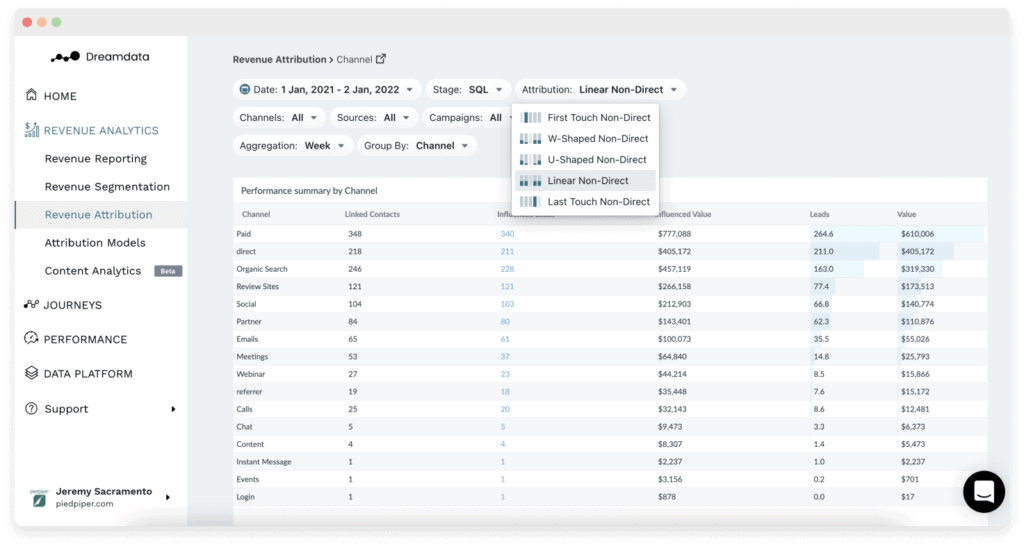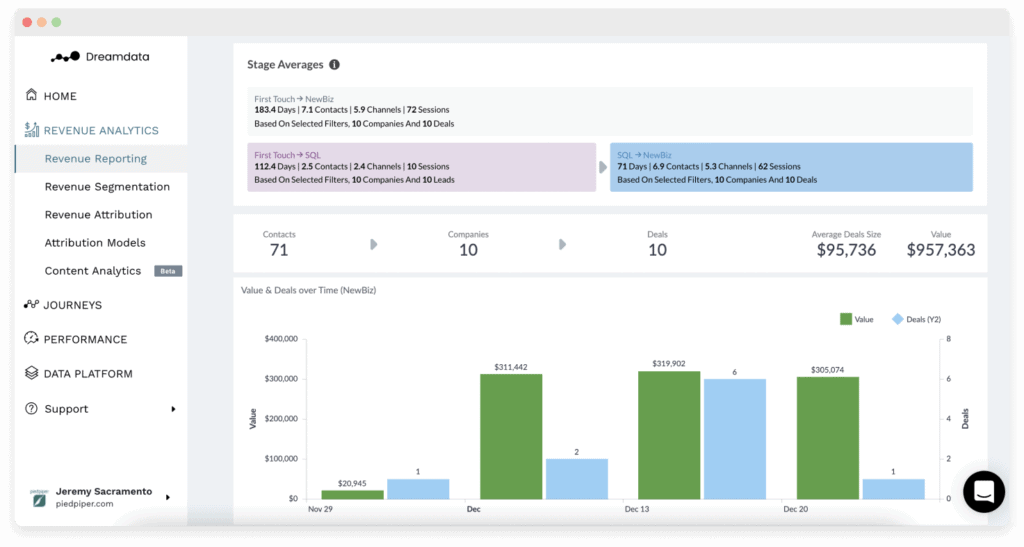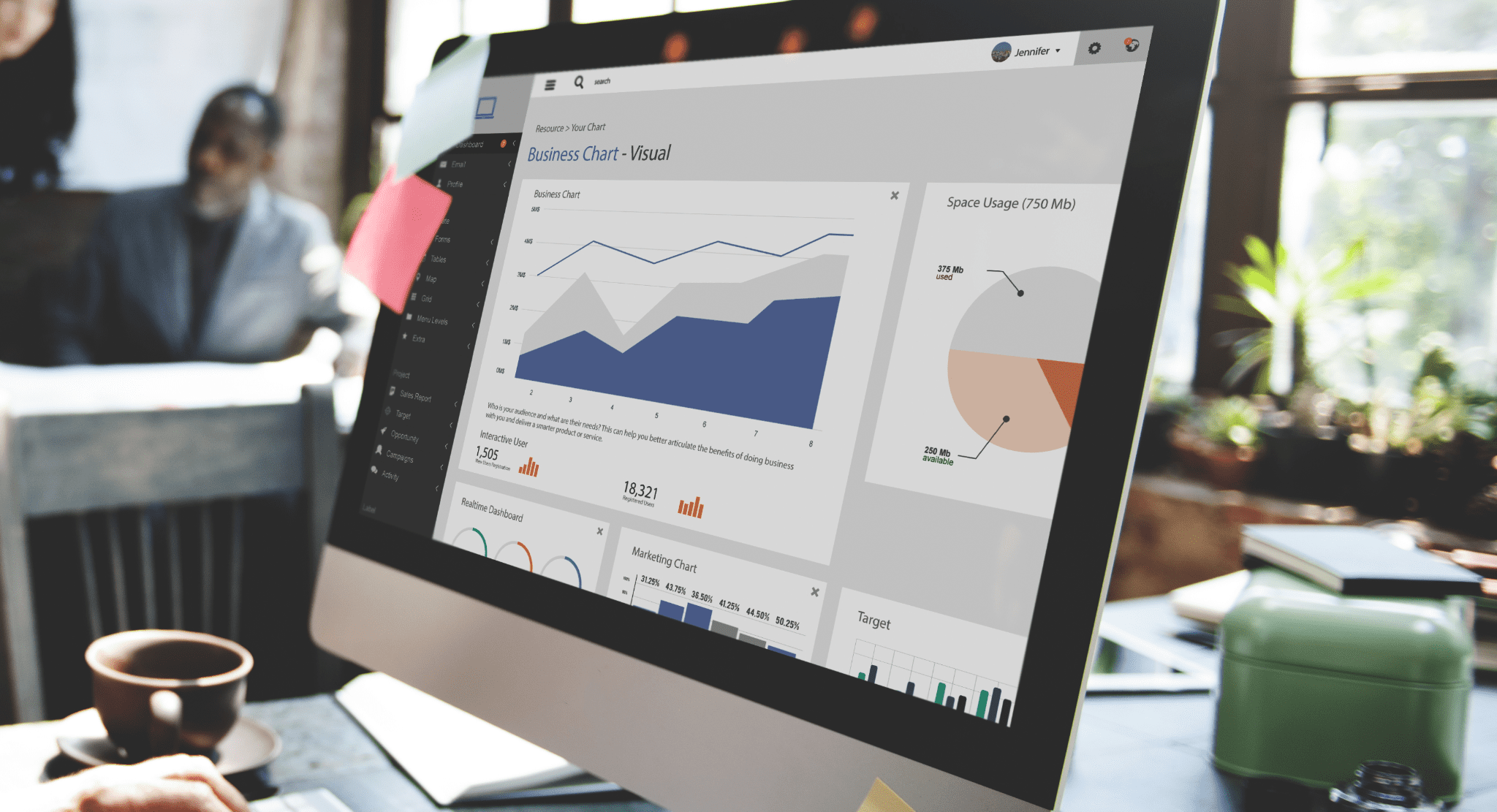How To Keep Track Of Your B2B Conversions With Revenue Analytics
B2B conversions can be complex and difficult to track. But with the right revenue analytics tools in place, you can easily keep tabs on your B2B conversion rate and make sure that your marketing efforts are paying off.
Revenue analytics is an invaluable tool for businesses of all sizes including B2Bs. According to the United States Small Business Administration, small businesses account for 44 percent of total U.S. sales or $5.9 trillion in revenue each year. By leveraging revenue analytics tools, businesses can gain valuable insights into their customers and optimize their operations to maximize their profits.
In this post, we’ll show you how to set up a system for tracking B2B conversions using Revenue Analytics. You’ll be able to see exactly where your leads are coming from and what’s driving them to convert. So let’s get started!
What Is Revenue Analytics?
Revenue analytics is a way to track how well your business is doing. You can use this information to see what is working and what isn’t so you can make changes on your B2B sales and marketing.
It is a data-driven approach to understanding the performance and profitability of a business. It uses various sources of data, such as customer demographics, purchase history, pricing strategies and marketing ROI analysis to identify trends within the company’s operations and inform better decision making. By employing revenue analytics, companies can maximize their profits while also controlling costs.
B2B companies can also use this data to analyze pricing strategies and determine the optimal price point for each product or service in order to maximize profit margins.
Application of Revenue Analytics
Product mix analytics is one of the applications of revenue analytics which involves looking at different types of products or services offered by a company, and understanding the profitability of each product line relative to sales volume. This helps businesses adjust their product mix strategies in order to ensure an optimal balance between cost control and higher profits.
Sales channel analysis is yet another important use case for revenue analytics tools, which enables companies to optimize the resources allocated across different sales and marketing channels (e-commerce websites, paid ads, distributors etc.) by understanding which ones generate more return on investment (ROI).
Lastly, to analyze marketing ROI, with marketing ROI analysis companies can measure the effectiveness of various marketing campaigns in terms of turning investments into profits.
In conclusion, Revenue Analytics is a powerful tool that enables businesses to make smarter decisions when it comes to pricing strategies, product mix analysis, sales channel optimization and maximizing ROI from marketing campaigns. This helps them maximize their revenues while also controlling costs in order to achieve maximum profitability.
5 Steps to Track B2B Conversions With Revenue Analytics
Tracking B2B conversions is essential for any business looking to maximize its revenue. With the right analytics tools, businesses can gain valuable insights into their customer’s buying behavior, allowing them to make better decisions about marketing and product development. Here are some of the steps companies can take to track B2B conversions using revenue analytics.
1. Define your business goals
Defining your business goals is a key first step to effectively managing and growing revenue. The best way to develop your revenue plan is to analyze your revenue analytics, as well as review historical revenue patterns, insights from customer data, and trends related to competitors. These metrics can help you understand which strategies have been successful in the past so you can adjust your planning for the future. Also consider what new revenue opportunities are available based on technological developments like artificial intelligence, automation and digital connectivity. With proper goal-setting in place, you’ll be better positioned to increase revenue and pursue greater success for your business.
2. Understand what data you need to track in order to meet those goals
Knowing which data to track is critical in achieving your goals. It’s great that you’ve identified objectives, but having the right data points – and understanding what they mean – will help you measure progress. By paying attention to the right metrics, you can make sure that you’re investing time and resources in the right efforts, while avoiding ineffective strategies. Don’t be afraid to ask an expert or consultant for advice if you are uncertain which data points are most relevant to your goals. With a little guidance and dedication, you’ll be able to develop key performance indicators (KPIs) that accurately reflect areas of growth or improvement.
3. Set up revenue analytics tracking for your website or app
Knowing how revenue analytics are performing is key to the success of any website or apps. Setting up revenue analytics tracking means having a better understanding of revenue drivers, money movement, and expenses; revenue forecasting; and marketing campaign performance. With precise revenue analytics tracking, you’ll have a bird’s-eye view into how your website or app is doing financially and can make well-informed decisions for revenue optimization. Don’t wait – revenue analytics tracking will help your business grow and maximize its potential for revenue.

One example is the Revenue Analytics by Dreamdata.io. Dreamdata.io is an innovative B2B revenue attribution platform designed to provide businesses with a comprehensive view of their customers’ purchase journeys. It gathers, joins, and cleans all revenue-related data from multiple sources and displays it in an actionable, transparent format that makes it easier to track conversions and optimize ROI.
In general, Revenue Analytics Tools are a type of software designed to measure, analyze and report on the financial performance of an organization. They allow users to track sales and revenue across various channels, as well as identify which products or services are driving the most profit. Revenue analytics can also be used to forecast future trends and financial performance.
These tools often integrate with existing enterprise resource planning (ERP) systems like SAP and Oracle, allowing organizations to get a comprehensive view of their finances. Revenue analytics tools come in both cloud-based and on-premises versions, and can often be customized to meet specific business needs.
If you’re considering using a revenue analytics tool, it’s important to think carefully about your objectives:
- Are you looking for more accurate reporting?
- Do you need to better understand customer behavior?
- Or do you simply want better visibility into how your organization is performing financially?
Once you have identified these goals, you can begin assessing what features best match them.
Many revenue analytics and b2b attribution software offer features such as dashboards that visually display key metrics like average order size or customer churn rates; predictive models that help anticipate future trends; and automated reports that allow users to quickly generate insights from large amounts of data. Additionally, some solutions offer more advanced capabilities such as machine learning algorithms that can detect patterns in data or AI-driven automation for more efficient processing time.

Regardless of the features offered by any given tool, the goal should always be ensuring accuracy and relevance when it comes to analyzing data — because while beautiful visuals may look nice, they don’t always reflect reality. With this in mind, make sure your chosen solution offers robust authentication controls so only authorized individuals can access sensitive information — and that it includes error checking measures such as validating input fields or filtering out irrelevant values right at the start.
By choosing an appropriate revenue analytics tool based on your individual business needs, you’ll be able to gain a deeper understanding of how your organization is performing financially — not just now but in the future as well. Also, it helps you understand recorded B2B revenue as per the rules and regulations. With this insight in hand, you’ll be able to make more informed decisions about where to focus resources for maximum impact — increasing efficiency and ultimately boosting profits!
4. Use the data you collect to improve your marketing and sales strategies
Data is a crucial part of marketing and sales strategies. To stay ahead of the competition and maximize revenue, it is necessary to collect relevant data, such as revenue analytics, customer feedback and more. By analyzing the data and making decisions based on facts instead of gut feeling, you can refine your revenue strategy. For instance, revenue analytics can tell you which promotions result in more revenue or the effectiveness of different sales techniques. With this insight, companies are able to hone their overall business strategy and focus on what works best for them. When used correctly, data collection can be an invaluable asset in optimizing marketing and sales outcomes.
![]()
5. Rinse and repeat!
Big data and revenue analytics don’t have to be intimidating. You can use a combination of existing data sources, as well as custom-built revenue analytics tools, to start taking control of your revenue lifecycle. With the right setup, you can start getting the insights you need to drive better decisions and ensure that you’re staying on top of the pulse of your revenue prospects. All it takes is a little bit of initiative, a smart approach to collecting metrics, and some basic understanding about how revenue analytics works for you. Rinse and repeat, so you can keep refining your own revenue strategy!
Your turn…
By following the five steps outlined above, you can set your business up for success by leveraging revenue analytics. You’ll be able to meet your business goals and improve your B2B marketing and sales strategies using the data you collect. Here are the key points to remember:
- B2B Businesses should use revenue analytics to track conversions and better understand their customers.
- By understanding which touchpoints are associated with specific conversion activities, B2B businesses can optimize their marketing efforts and ensure they are driving ROI.
- However, many B2B businesses struggle with tracking conversions due to a lack of data or the challenge of integrating data from disparate sources, this is where a Revenue Analytics Tool comes in.
- With the right tools and approach, tracking B2B conversions doesn’t have to be a daunting task – it can be a valuable insight into your customers’ journey and help you drive more ROI for your business.




